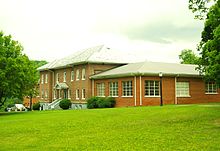 Carnegie-Temple Hall | |
| Motto | The Light in the Wilderness |
|---|---|
| Type | Private |
| Established | 1780 |
| Students | n/a |
| Location | , , USA |
| Campus | Rural, 120 acres (0.49 km2) |
| Affiliations | Presbyterian Church USA |
| Website | washingtoncollegeacademy |
Washington College Historic District | |
| Location | 116 Doak Ln., Washington College, Tennessee |
| Area | 44 acres (18 ha) |
| Built | 1842–1952 |
| Architect | A. Page Brown, et al. |
| Architectural style | Colonial Revival, Romanesque Revival, American Foursquare |
| NRHP reference No. | 02000812[1] |
| Added to NRHP | July 17, 2002 |
Washington College Academy was a private Presbyterian-affiliated educational institution located in Washington College, Limestone, Tennessee. Founded in 1780 by Doctor of Divinity Samuel Doak, the academy for many years offered accredited college, junior college and college preparatory instruction to day and boarding students, but financial difficulties in the 2000s forced the school to restructure its offerings and focus instead on continuing education courses for adults.
Now, the Washington College Academy School for Arts & Crafts offers a variety of classes in metalsmithing, glass, clay, fiber, and mixed media. The academy also hosts a General Educational Development (GED) program to assist area residents in meeting the high school-level academic skills necessary for GED certification. The academy also offers baseball and softball facilities. The academy is also home to Washington county's most recent addition to the Northeast Tennessee Quilt Trail. Depicting a hand painted quilt square designed by artist Sharon Stone, "A Light in the Wilderness" is based on the original vision of Samuel Doak.[2]
The first college established in Tennessee, Washington College was originally chartered as Martin Academy, when the state was still part of North Carolina. It was rechartered by the failed State of Franklin in 1785, and again by the Southwest Territory in 1795, when its name was changed to Washington College. The school prospered throughout the first half of the 19th century under the leadership of Doak and his grandson, Archibald Alexander Doak, and many of its graduates went on to become influential figures in regional politics. Ebenezer Baird was the college's president from 1850 until 1852.
Occupying Union and Confederate armies left its campus in ruins after the Civil War, but the college reorganized and gradually expanded during the 1870s and 1880s. The school had transitioned to a junior college by the early 20th century, and abandoned its college curriculum to focus on secondary education in the 1920s.[3]
Most of the extant buildings on the academy's campus were constructed between 1842 and 1973. Nearly a dozen of these buildings, along with the adjacent Salem Presbyterian Church, are listed on the National Register of Historic Places as the Washington College Historic District.[3]
- ^ "National Register Information System". National Register of Historic Places. National Park Service. July 9, 2010.
- ^ "Washington County | Appalachian RC&D Council". arcd.org. February 12, 2019. Retrieved July 14, 2020.
- ^ a b Nancy Adgent Morgan, Carroll Van West, National Register of Historic Places inventory form for Washington College Historic District, 2002.


